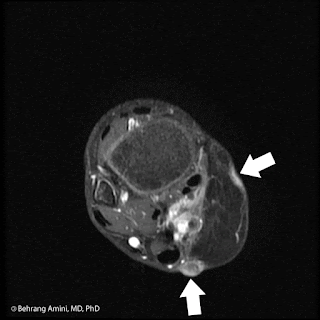
T1 axial post-contrast MRI of a keloid or hypertrophic scar formation along the margins of a myocutaneous flap. The enhancement can fool you into thinking that there is recurrent tumor, but the linear pattern along the flap margin is the clue that this is related to the scar.
Keloids and hypertrophic scars are fibroblastic proliferations of the dermis. Their morphologic and pathologic features overlap. They are associated with trauma, infection, and connective tissue diseases. They do not spontaneously regress and tend to recur after surgical excision, so surgery is often combined with topical corticosteroid injection or, less commonly, radiation therapy.
In contrast to hypertrophic scars, keloids tend to grow beyond the margins of the injury site, have keloid collagen, and are less likely to stain for smooth muscle actin. Keloids have a higher recurrence rate than hypertrophic scars.
Keloids are hypocellular and are composed of dense collagen. The abundance of type I collagen results in low T2 signal. Keloids occur most frequently in patients aged 15–45 years. People of African and Chinese origin have a higher predilection for keloids. The face, shoulders, forearms, and hands are most commonly affected. They tend to occur where there is increased skin tension
No comments:
Post a Comment
Note: Only a member of this blog may post a comment.